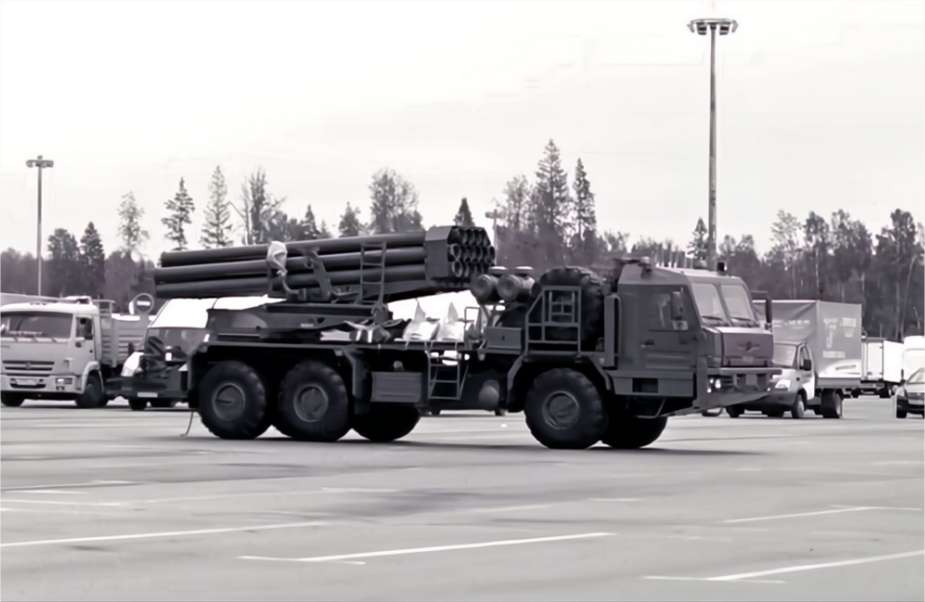Russian Army deploys new version of BM-27 Uragan MLRS Rocket Launcher in Ukraine
On April 16, 2024, the Russian Ministry of Defense released a video showing a night-time operation involving the BM-27 Uragan 220mm multiple launch rocket system (MLRS) near the Belgorod region. Notably, the video unveiled an updated version of the BM-27 Uragan launcher mounted on a new platform, identified as the BAZ-69092 three-axle chassis, marking a significant departure from its traditional ZIL-135LM 8x8 truck chassis.

The transition to the BAZ-69092 chassis is part of an ongoing modernization effort within the Russian Army to upgrade existing military equipment and improve its artillery capabilities. This strategy includes plans to replace the aging BM-27 Uragan MLRS with the more advanced Tornado-S system. As reported by Army Recognition on November 21, 2023, the Tornado-S will serve as the basis for a forthcoming robotic 300 mm MLRS currently under development by the Russian state corporation Rostec.
The history of the BM-27 Uragan includes several phases of development and modification since its introduction in 1975. An initial effort to develop a new chassis in the mid-1990s was discontinued due to financial constraints. The project was later revived by the Bryansk Automobile Plant, part of the VKO "Almaz-Antey" concern, leading to the integration of the Uragan MLRS onto the BAZ-69092 chassis. This adaptation is one of several initiatives aimed at updating the aging Uragan system.
For instance, the Russian Uragan-1M, a bi-caliber MLRS developed to replace the older BM-27 Uragan 220 mm and BM-30 Smerch 300 mm systems, began development in 1995 and concluded with successful trials in 2015. Despite these developments, as of 2023, only six units of the Uragan-1M had been produced, and it had not yet been officially adopted by the Russian Army.
Ukrainian military engineers have also been working on modernizing their BM-27 MLRS. They adapted the Uragan launcher to fit on a Tatra Т815-7Т3RC1 chassis, resulting in the creation of the Bureviy system. Revealed in 2020 and developed by the Shepetiv Repair Plant, the Bureviy successfully completed fire tests in November 2020. Additionally, Ukraine developed the Bastion-03, which combines a KrAZ-6322 chassis with a 9K57 Uragan MLRS launcher. This latter project is part of a Ukrainian initiative to standardize rocket artillery chassis using the KrAZ platform, following the earlier Bastion-01 and Bastion-02 models.

The Russian transition to the BAZ-69092 chassis seems to be motivated by several factors. Firstly, the Russian Army lost at least 83 units in Ukraine since the beginning of the conflict. As of 2023, the Russian Army had only 150 of these vehicles in service, indicating a critical need for the modernization and replacement of this valuable system. Secondly, Russian engineers could face difficulties in modernizing older vehicles such as the ZIL-135LM, whose production ceased in 1995. Thirdly, these difficulties need to be compared with the advantages offered by new platforms for improving combat efficiency. The adoption of the newer BAZ-69092 6x6 chassis offers several advantages, including its capacity to accommodate weapons systems weighing up to 13 tons, but also aligns with Russian strategic preferences for local production.
Moreover, this chassis is used for various Russian military vehicles, including some variants of the S-300 and S-400 transport erector launchers (TELs), the 2S43 Malva 152mm self-propelled howitzer, the REM-KS recovery vehicle, the Krasukha-2 electronic warfare vehicle, and the 64L6 Gamma-S1 3D radar.
It is interesting to note that the BAZ-69092 chassis was specifically developed to standardize and facilitate the use of various military and special vehicles within the Russian army. This initiative began in the early 1990s after the dissolution of the Soviet Union, which affected the supply of special chassis as key manufacturers were outside Russia (for instance MKZT in Belarus and KrAZ in Ukraine). The Bryansk Automobile Plant (BAZ) was tasked with developing the BAZ-69092 under the project code "Voshchina-1" to substitute for foreign-made chassis. The model is part of a family of vehicles designed for diverse functions, including combat and support roles, tailored to meet specific requirements of the military.
The BAZ-69092 chassis incorporates a welded ladder-type frame with a cab-over-engine design, powered by a 450-horsepower multi-fuel turbocharged diesel engine. This design supports a three-axle all-wheel drive system and is built to accommodate a variety of configurations, ranging from basic cargo platforms to complex systems like missile launchers or radar equipment. It has a carrying capacity of 13 tons, with a total allowable weight of 28.7 tons, and can reach speeds up to 80 km/h with a range of 1000 km.
The BM-27 Uragan itself, also known as the "Hurricane," is a self-propelled multiple rocket launcher (MRL) system developed by the Soviet Union and introduced in the late 1970s. It is mounted on a ZIL-135 8x8 truck chassis and equipped with a 16-tube launcher for 220mm rockets. Capable of hitting targets up to 70 kilometers away, it can deploy high-explosive or cluster munitions effectively against area targets. Each launcher can fire all its rockets in less than 20 seconds, enabling rapid saturation of enemy positions. The Uragan's mobility and quick firing capability facilitate shoot-and-scoot tactics to reduce vulnerability to counter-battery fire, making it highly valuable for Russian soldiers in Ukraine.








